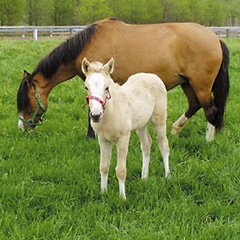Animal Resource Science Center

The center, which was established in 1949 as a livestock farm for teaching undergraduate students, is located in Ibaraki prefecture, 90 km north from the main campus. Two professors (veterinary experimental animal and animal life science), 1 assistant professor (veterinary physiology), 9 technical assistants including a veterinarian, 2 management staffs and 2 part-time assistants support the teaching and research for veterinary medicine, animal life science and animal biotechnology. Eight graduate school students, who belong the research unit of animal life sciences, investigate the frontline subjects of animal biotechnology.
Six practices, 4 seminars and 5 lectures for undergraduate students and 2 practice, 2 seminars and 7 lectures for graduate students are performed as educational facility in the center. Many practical seminars on animal life sciences were offered for pupils of kindergartens, elementary schools and junior high schools, and for citizen, and the center acts as social education center for assess the feed and food safety.
Twenty horses including Criollo breed horses, which are gifts from La Plata University, Argentina, and helpful for animal therapy, 30 daily cows and 5 beef cattle, 20 miniature pigs, and 250 Shiba breed goats, which are bred in the center and useful as experimental animal for ruminants. Many of these farm animals were provided to many research institutes as experimental animals for veterinary medical, animal science and medical fields.
Recent research subjects in the research unit of the center are as follows:
(1) Fundamental physiology of mammalian embryos and reproductive organs. Molecular studies on the mechanism of programmed cell death, apoptosis, in mammalian ovaries, follicular granulosa cells, oocytes and luteal cells (detection of novel cell-death receptor and its decoy receptor, elucidation of intracellular apoptosis signal transducing pathway, detection of intracellular inhibitory factors of apoptosis etc.).
(2) New-creation of artificial manipulation methods to rescue the potential oocytes in mammalian ovaries by in vivo gene-transfection and RNA silencing techniques.
(3) Development of accurate control techniques of estrous cycle to improve the artificial insemination in farm animals.
(4) Safety and risk assessment of feeds and animal-derived foods, and safety assessment of environmental pollutants on embryonic development in mammals.
(5) Studies on nutritional effects of amino acids on infantile growth and prevention of mastitis gastric ulcer in farm animals.
(6) Cellular and molecular studies on the extracellular matrix metabolisms and pathogenesis of fibrotic diseases, renal glomerulofibrosis and hepatic fibrosis in experimental farm animals.

